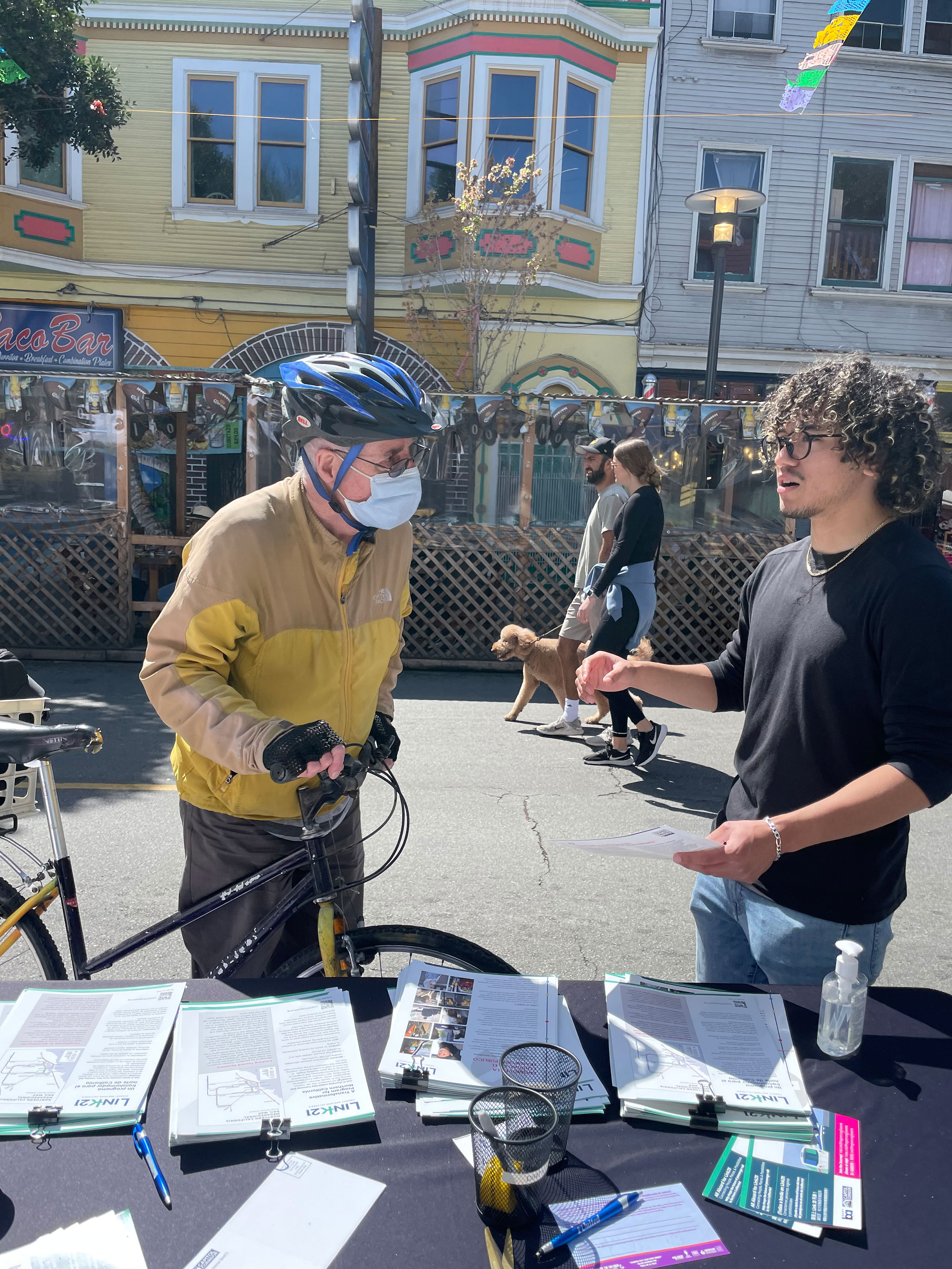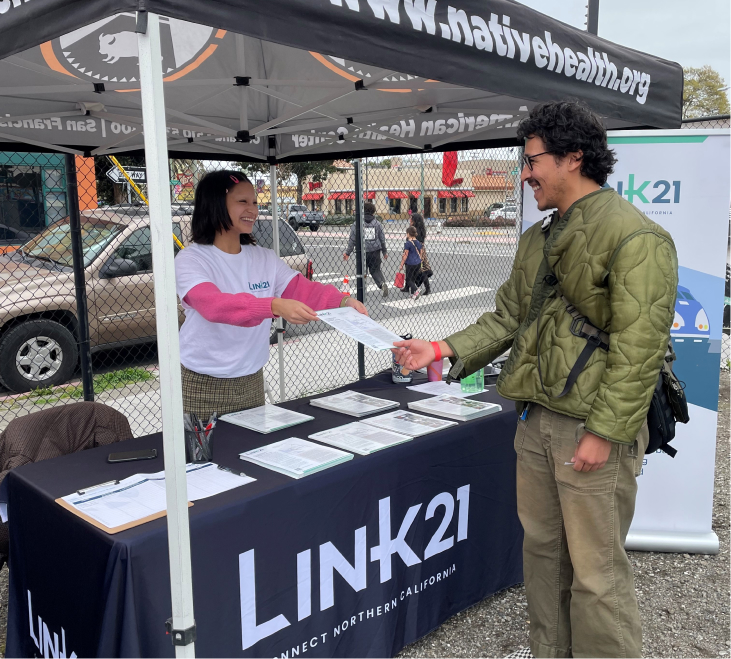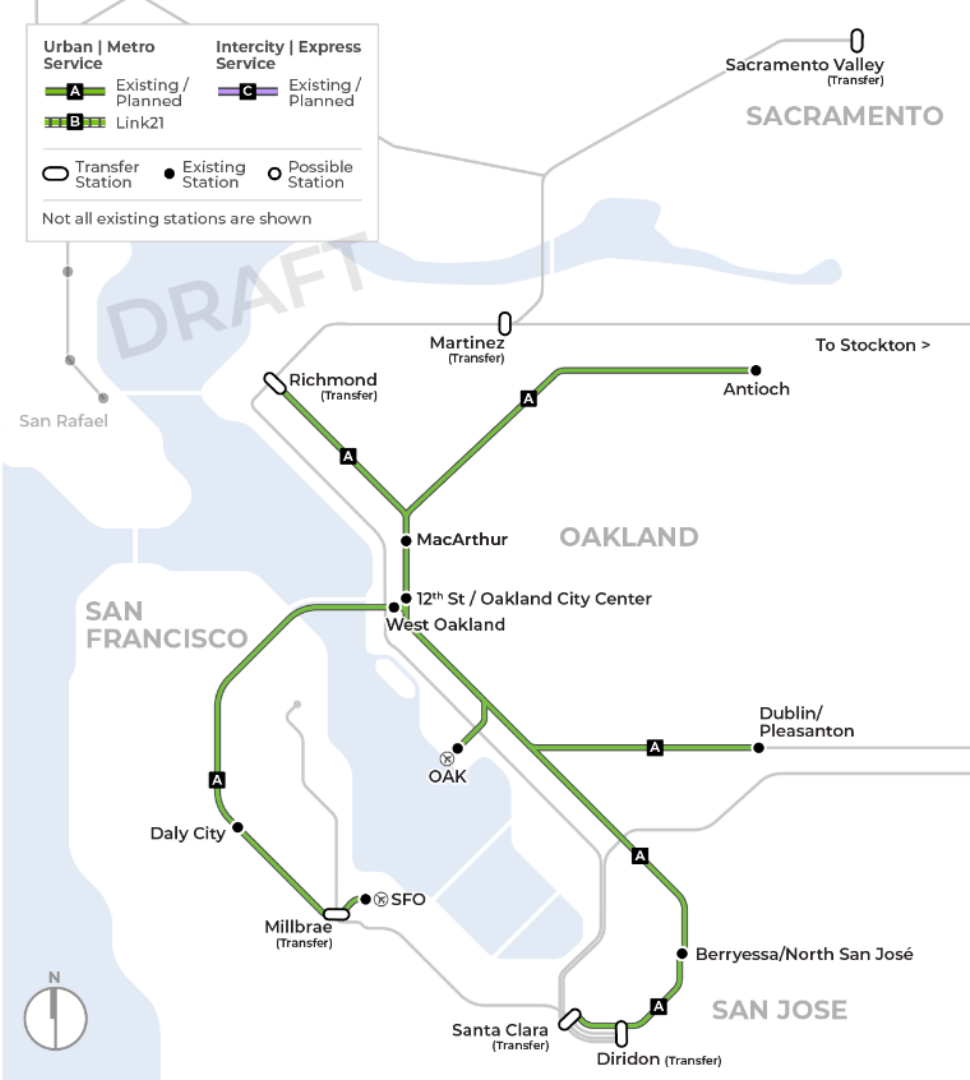What is Link21 and Why Do We Need It?
Link21 is a passenger rail Program that aims to improve train travel and connection of the rail network in Northern California. The centerpiece of the Program is a second train crossing between San Francisco and Oakland as envisioned in the California State Rail Plan. Along with the new crossing to accommodate travel within the congested Transbay corridor, Link21 includes improvements to both San Francisco Bay Area Rapid Transit District (BART) and Regional Rail networks to provide safe, efficient, equitable, and affordable travel for all trips within the Bay Area and across the Megaregion.
Economy, Jobs & Housing
As the fifth largest megaregional economy in the country, Northern California's residents experience a high cost of living that has resulted in many residents moving further away from jobs and school in search of affordable housing. As our population continues to grow we must provide travel options to allow residents to move conveniently around the Megaregion.
Roadway Congestion & Climate Risks
The imbalance of jobs to affordable housing has resulted in the need to travel longer distances to access destinations. This leads to persistent traffic and travel delays on local freeways. Many freeways are back to pre-pandemic congestion which causes hours of travel delays and unreliable trips while stuck in traffic. Transportation is a major contributor of pollution and climate-change and we must look for cleaner travel solutions to meet air quality goals for the region and improve our health.
Passenger Rail Service & Infrastructure
While our passenger rail system is extensive, it is disconnected, and has limited routes and service which can make traveling by train inconvenient or not an option at all. Also, having only one Transbay rail crossing between San Francisco and Oakland (BART tube) — one of the most traveled corridors — limits service reliability and redundancy for riders in the event that the tube is shut down for maintenance. Better connecting the train network and communities it serves will build ridership, shifting more travel from cars to train which will provide benefits to all types of travelers.
Train Travel Comparison
How does Northern California measure up?

Max Distance by Rail
~35 miles in an hour

Max Distance by Rail
~55 miles in an hour

Max Distance by Rail
~80 miles in an hour

Max Distance by Rail
~85 miles in an hour
-
 Areas accessible from each city’s downtown within 1-hour of travel by
passenger rail. Data is based on agency timetables.
Areas accessible from each city’s downtown within 1-hour of travel by
passenger rail. Data is based on agency timetables.
- Passenger rail lines, excluding light rail, that connect directly to each city’s downtown. On the San Francisco map, rail lines that do not directly connect to downtown are also shown.
Benefits Beyond Link21 Crossing
A new rail crossing unlocks local and regional travel benefits across the whole train network. Even people who live far away from the crossing, such as in the Sacramento and the San Joaquin Valley or to the South, will have the ability to travel by rail between places more directly and conveniently.
Connected Markets
- Exploring opportunities to connect communities in the Megaregion
Improved Service
- Increase frequency and faster travel times
- Enhance access and create faster transfers between BART and Regional Rail networks
Modern Train Technology
- Greener, lighter, and faster trains
- Track, speed, and vehicle type
Improved Infrastructure
- Tracks, structures, signaling, and facilities
Link21 Program Goals
The Link21 vision identified within the Business Case for the Program, is to transform the BART and Regional Rail (including commuter, intercity, and high-speed rail) network into a faster, more integrated system that provides a safe, efficient, equitable, and affordable means of travel for all types of trips. Link21, along with partner agencies who all are working to improve our train network in Northern California, seeks to enhance livability, community stability, economic opportunity, and environmental quality while improving the travel experience.
Goals & Objectives
Click or tap the items below to learn more.
- Provide better service
- Improve reliability and system performance
- Build ridership and mode share
- Connect people and places
- Improve safety, health, and air quality
- Advance equity and community stability
- Improve access to opportunity and employment
- Connect major economic, research, and education centers
- Enable transit-supportive and equitable land use
- Increase climate change resilience
- Reduce greenhouse gas emissions
- Conserve resources
Equity Commitment
To advance equity in the Megaregion through accessible and connected passenger rail service so that all people, regardless of their background, have the same opportunity to live happy and healthy lives.
Integrated into Planning and Analysis
- Equity Vision Statement and Blueprint
- Goals, Objectives, and Metrics
- Defining Priority Populations
Equitable Engagement
- Direct and accessible outreach
Community-Based Partnerships & Co-Creation
- Prioritizing communities that have been marginalized
- Partnering to understand needs and identify opportunities
Equity Advisory Council (EAC)
- 18 community representatives from Megaregion
- Regular meetings to review information and advise Program
Priority Populations
Link21’s priority populations are geographic areas most impacted by negative economic, mobility, community, health, and safety outcomes. By identifying communities currently experiencing inequitable outcomes, the Program is able to partner with those populations to better understand their needs and design a program that addresses them.
Planning Phases and Timelines
The Link21 Program is a multi-phase, long range planning process that includes close coordination with Megaregional agency partners, community stakeholders, and the public throughout each phase of work. We are currently in Phase 1 which is working to identify, assess, and refine concepts for future rail project investments.
Click or tap on the Phases to learn more.
Phase 0 included foundational work that established Link21's Business Case framework outlining the Program's Vision, Goals and Objectives, and set a decision-making process for evaluating concepts that will ultimately identify future projects. Phase 0 focused on early data gathering, technical work, and stakeholder and public input that included establishing an equity commitment and partnership program with community-based organizations to co-create future rail solutions.
Phase 1 Focus
What are we doing?
- Identifying potential service improvements
- Assessing benefits of different train technologies to achieve desired service
- Collecting early environmental data and input to guide Concept exploration, evaluation and refinement
Where are we headed?
- Understanding benefits and tradeoffs of concepts and making a decision on which train technology will be used in the new crossing
Why does it matter?
- Defining train technology affects the passenger experience Link21 can provide and how we will connect to and improve service within the larger train network. This is an important first step to further define concepts that will ultimately lead to identification of a future project.
Phase 1 Concept Exploration Process
The process and criteria for analyzing concepts was established through the Link21 Business Case in early 2021 and provides a framework for decision-making.

Phase 2 will advance the Program forward from Concepts towards identification of Project Alternatives through ongoing analysis and public input. Project Alternatives are required by federal and state laws to have a full detailed environmental analysis performed to identify potential impacts and mitigations to minimize harms to environmental resources as a result of the future Project. This environmental process is known as the National Environmental Policy Act (NEPA) and the California Environmental Quality Act (CEQA).
Phase 2 will also establish an approved Project and associated implementation strategy for delivery.
Phase 3 will focus on Project Delivery will focus on the final design of the approved project, and associated funding strategy. Once the final design is completed and approved, a multi-year construction stage will begin followed by testing of the system and ultimately opening of service.
Link21 Business Case Framework
A data-driven comparison to understand the value of different rail solutions and seeks to answer key questions. Within the four different cases of the framework, there are established criteria or metrics to measure proposed concepts against to ensure they meet Link21 Goals and Objectives.
Strategic Case
Does Link21 achieve the desired benefits, goals, and objectives?
Examples of Strategic Metrics
- Travel time savings
- Ridership
- Reliability
- Benefits to priority populations
- Accessibility to rail
Economic Case
What is the economic value to the Megaregion?
Examples of Economic Metrics
- Cost effectiveness
- Economic benefits
Financial Case
What are the financial implications?
Examples of Financial Metrics
- Capital costs
- Operations and maintenance costs
- Fundability
Deliverability Case
How can the project be delivered and what are the key risks?
Examples of Deliverability Metrics
- Constructability
- Equitable land use
- Environmental
- Right-of-way
Evaluation considers how concepts perform within multiple potential future (2050) scenarios — consistent with Plan Bay Area 2050. For a full list of metrics: https://link21program.org/en/program/business-case.
Phase 1 Progress
Exploring concepts to meet Link21 Goals and Objectives.
 Planning Work
Planning Work
- Identified options for improved service
- Ongoing concept evaluation and refinement
- Ridership modeling and development of preliminary cost estimates
 Early Environmental Work
Early Environmental Work
- Initial data collection on social and natural resources
- Identification of environmental constraints and opportunities to support concept development
- Identification of potential Environmental Justice effects and benefits
- Development of preliminary purpose and need statement
 Public Engagement
Public Engagement
- Established the Equity Advisory Council
- Ongoing listening, learning and public input gathering
- Conducted hundreds of Equitable Engagement activities which focused on communities that have been marginalized
Environmental Justice?
Environmental justice is the fair treatment and meaningful involvement of all people regardless of race, color, national origin, or income.
Concept Exploration To-Date
Market Connections
- Community access
- Ridership potential
- Integration with existing network
- Project boundaries
Service Planning
- Routes
- Frequencies
- Stops
- Transfers
- Reliability
Train Technology Benefits
Exploring which technology will be in the crossing:
- BART (broad-gauge track)
- Regional Rail (standard-gauge track)
- Both broad- and standard-gauge tracks
Infrastructure Needs
Potential features, such as:
- Underground structures
- Construction method consideration
- Community impacts
Track Types and Train Technology
This table outlines differences in the two train technologies being considered in the new crossing. Both currently exist in the Bay Area and have different characteristics. While both technologies provide benefits to our riders, Link21 is exploring the trade-offs to identify a solution to meet the needs of our evolving Megaregion.
| Characteristics | BART on Broad Gauge | Regional Rail on Standard Gauge |
|---|---|---|
| Operators |
|
|
| Track |
|
|
| Vehicle Type |
|
|
| Speed |
|
|
| Propulsion |
|
|
| Service Types |
|
|
| Performance |
|
|
* The average speed will be lower based on the number of and distance between stops, as well as availability of straight track.
Engagement Highlights
Over the past few years, the Link21 Team has heard from community members about their desires for better, more reliable, and accessible travel options; specifically, what is important when taking a train to get them where they need to go. Service improvements like frequency, travel time, connection, and convenience were themes that rose to the top.
Fall 2022 Engagement Highlights
-
 3.1 million digital ad impressions (views)
3.1 million digital ad impressions (views)
37,000+ webpage views -
 39 virtual stakeholder and public presentations
39 virtual stakeholder and public presentations
-
 22 in-person community events
22 in-person community events
Direct connections with more than 1,800 people last fall.
What We've Heard
Link21 is committed to hearing people’s lived experiences and understanding the community’s needs. During our fall engagement a variety of feedback was received. Below summarizes the top themes were heard from community members.
Need for travel beyond access to jobs
- To airports, entertainment, or to visit family & friends
Desire for connection to megaregional destinations
- Sacramento to East Bay and / or San Francisco
- Santa Cruz / Salinas / Monterey to Oakland / East Bay
Need for more reliable travel options across the Bay
- San Francisco to Oakland / Alameda / Emeryville / Berkeley
- Peninsula / Silicon Valley / San Jose to East Bay
Desire for extended service hours and increased frequency
- Evening, overnight and weekend hours


What We’ve Learned Through Concept Analysis
- Meets anticipated transbay travel demand by 2050
- Improves service reliability and provide needed redundancy
- Enables increased train frequency that can grow ridership — must be balanced with operating costs & larger fleet
- Provides benefits to priority populations across the network in different ways
- Reduces potential future crowding in the existing BART crossing
- Supports other rail improvements / projects by connecting them to the new rail crossing
- Provides geographically distributed benefits with increased frequency of service on all east bay lines
- Benefits regional rail riders crossing the Bay with a new centrally-located transfer in Oakland
- Provides benefits to priority population communities throughout the BART network
- Generates additional ridership with new rail access in San Francisco’s Mission Bay and in Alameda
- Transbay service to Richmond serves strong markets — farther north has fewer benefits with greater land use & environmental risks
- Generates high ridership by extending Caltrain service through crossing to east bay
- Increased transbay service south of Salesforce Transit Center has potential to increase ridership and benefits to priority populations
- Meets megaregional travel need with direct service across the Bay to San Francisco and the Peninsula with potential for one-seat rides (no transfer)
- Compatible with other operators and improvement projects like Caltrain Electrification and Downtown Extension
Service Improvement Planning
To transform the passenger experience, Link21 is looking at routes and stops, schedules, train frequency, speed and travel time, technology, track type and reliability. Future service that Link21 provides includes offering riders Urban | Metro and Intercity | Express service options to reach their destinations and meet travel needs.
Urban | Metro Service
Urban | Metro is a type of service that operates within metro regions at higher frequencies and medium average speeds. BART provides this service today. Caltrain will provide this type of service with its modern electrified trains starting in 2024.
- More frequent trains (every 2-10 minutes)
- More stops / shorter distances between stations (1-5 miles apart)
- Medium average speeds
Intercity | Express Service
Intercity | Express is a type of service for medium to long trips that connects regions, as well as urban and rural communities, at lower frequencies and higher average speeds. Operators like Capitol Corridor, Amtrak, San Joaquins, Altamont Corridor Express, and others provide this service on shared tracks owned by private freight rail.
- Less frequent trains (every 30 minutes-1 hour+)
- Fewer stops / longer distances between stations (5+ miles apart)
- Higher average speeds, faster travel times
Click on rail service options below to explore their system maps.
Regional Rail in Crossing
BART in Crossing
Click on service options below to see current and proposed routes and stops.
![]() See how Regional Rail in the crossing providing Urban |
Metro Service could transform today’s trip from Emeryville to
Redwood City.
See how Regional Rail in the crossing providing Urban |
Metro Service could transform today’s trip from Emeryville to
Redwood City.
Click on service options below to see current and proposed routes and stops.
![]() See how
Regional Rail in the crossing providing Intercity | Express
Service could transform today’s trips from Sacramento to
Salesforce Transit Center, and Stockton to Powell
Street.
See how
Regional Rail in the crossing providing Intercity | Express
Service could transform today’s trips from Sacramento to
Salesforce Transit Center, and Stockton to Powell
Street.
Click on service options below to see current and proposed routes and stops.
![]() See how
BART in the crossing providing Urban | Metro Service could
transform today’s trips from Martinez to Mission
Bay/UCSF and Fremont to 4th &
Townsend.
See how
BART in the crossing providing Urban | Metro Service could
transform today’s trips from Martinez to Mission
Bay/UCSF and Fremont to 4th &
Townsend.
Regional Rail — Concepts A & B
The Link21 Team is currently focused on identifying, assessing, and refining concepts that included a new train crossing between Oakland and San Francisco, as well as infrastructure improvements for both BART and Regional Rail.
Link21 is seeking feedback on the current draft concepts. These concepts show different possibilities for where the crossing could be located, and how it would connect to existing BART and Regional Rail networks.
As work continues through this current program phase, concepts will continue to be refined.
Concept A
Salesforce Transit Center (San Francisco)
via Alameda
Click to enlarge
Service Benefits:
- Offers both Urban | Metro and Intercity | Express service on regional rail tracks
- Prioritizes Oakland connection to BART over shorter travel time between East Bay and San Francisco
- Creates new connection in West Oakland (transfer between Regional Rail and multiple BART lines)
- Connects to Salesforce Transit Center offering riders an easy trip to the Peninsula / Silicon Valley
Concept B
Salesforce Transit Center (San Francisco)
via Port of Oakland
Click to enlarge
Service Benefits:
- Offers both Urban | Metro and Intercity | Express service on regional rail tracks
- Prioritizes shorter travel time between East Bay and San Francisco over more station stops in Oakland
- Creates new connection in West Oakland (transfer between Regional Rail and BART for southbound riders)
- Connects to Salesforce Transit Center, offering riders an easy trip to the Peninsula / Silicon Valley
BART — Concepts C & D
Concept C
1st & Howard (San Francisco) via
Alameda
Click to enlarge
Service Benefits:
- Increases Urban | Metro service and includes stronger connection to Intercity | Express service on Regional Rail tracks
- Creates new connection in Oakland Jack London (transfer between Regional Rail and multiple BART lines)
- Serves Market Street / Financial District in San Francisco (near Salesforce Transit Center for Regional Rail service to the Peninsula / Silicon Valley)
Concept D
3rd & Mission (San Francisco) via Mission
Bay and Alameda
Click to enlarge
Service Benefits:
- Increases Urban | Metro service and includes stronger connection to Intercity | Express service on Regional Rail tracks
- Creates new connection in Oakland Jack London (transfer between Regional Rail and multiple BART lines)
- Serves Mission Bay / UCSF in San Francisco and 4th / Townsend station to transfer to Regional Rail service to reach Peninsula / Silicon Valley
Regional Rail — Concepts E & F
Concept E
Salesforce Transit Center (San Francisco)
to MacArthur via Alameda
Click to enlarge
Service Benefits:
- Offers both Urban | Metro and Intercity | Express service on Regional Rail tracks
- Prioritizes Oakland connection to BART over shorter travel time between East Bay and San Francisco
- Creates new connection at MacArthur station in Oakland (transfer between Regional Rail and multiple BART lines)
- Connects to Salesforce Transit Center offering riders an easy trip to the Peninsula / Silicon Valley
Concept F
Salesforce Transit Center (San Francisco)
to Oakland City Center via Alameda
Click to enlarge
Service Benefits:
- Offers both Urban | Metro and Intercity | Express service on Regional Rail tracks
- Prioritizes Oakland connection to BART over shorter travel time between East Bay and San Francisco
- Creates new connection in Downtown Oakland (transfer between Regional Rail and multiple BART lines)
- Connects to Salesforce Transit Center offering riders an easy trip to the Peninsula / Silicon Valley
Moving Forward
Ongoing Activities
- Collaboration with cities and agencies
- Megaregional stakeholder engagement
- Equity Advisory Council (bi-monthly meetings)
- Concept refinement and evaluation
Program Milestone Activities
- Fall 2023: Megaregional Outreach Events
- Analysis update
- Train technology and concept options
- Input gathering
- Early 2024: BART and Capitol Corridor Board Presentations
- Recommendation of train technology in crossing
- Extents of initial Link21 project

Engagement Events
Online Open House
- This website will be live from June 21 – August 31
Virtual Community Meeting
On June 27, the Link21 Team hosted a virtual meeting to present project information and answer questions.
View the recording on our website.
Virtual Office Hour
On June 29, the Link21 Team hosted a virtual session to answer follow-up questions.
View the recording on our website.
In-Person Open Houses
Thank you to all who attended our in-person open houses throughout the month of June.
-

Community Events and Presentations
855-905-Link (5465) -

Website
Link21Program.org -

Social Media
#Link21
























